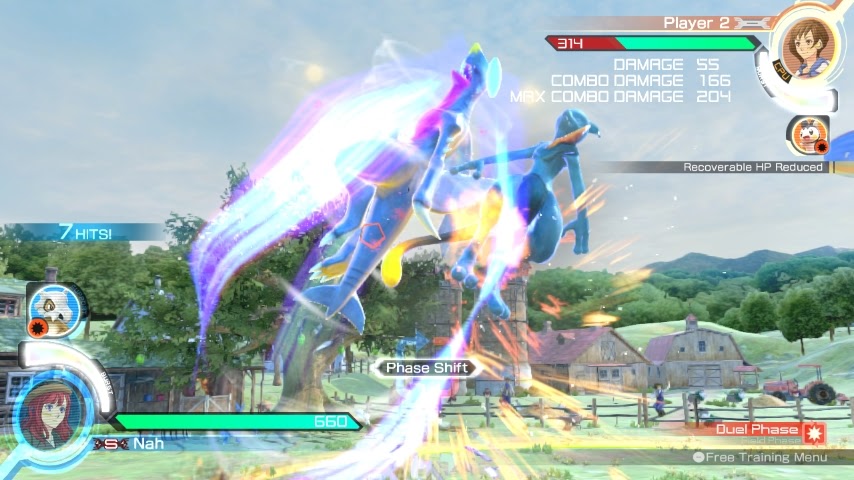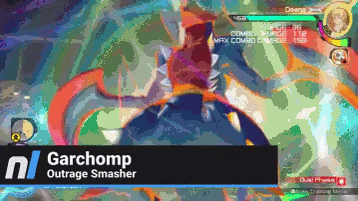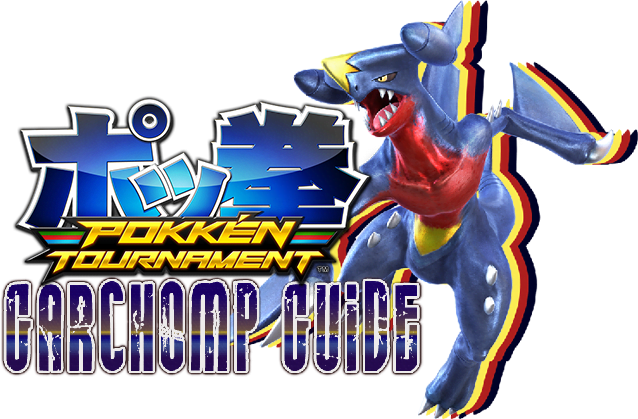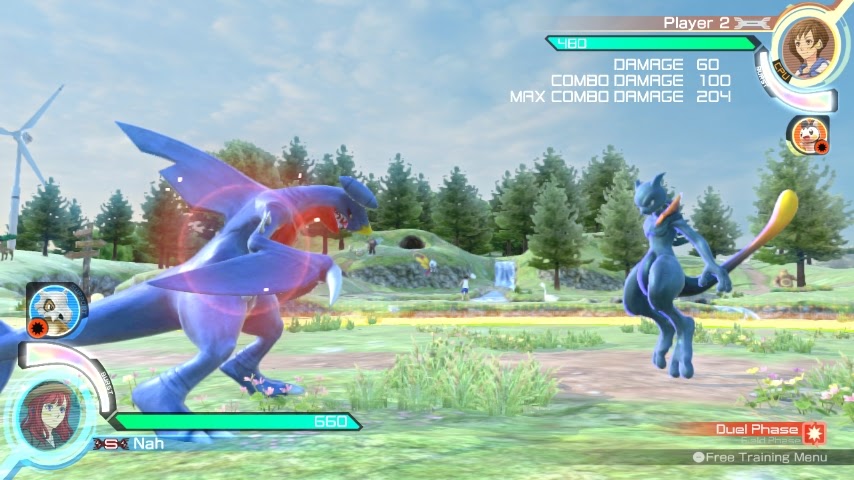Pokkén Dojo: Gunning with Garchomp
A brief guide to using Garchomp in Pokkén Tournament. Learn about its important moves, combos, and general gameplan.
Welcome to Pokkén Dojo! In this article series we’ll give you PokéCommunity members’ hint and tips to using a character in the game Pokkén Tournament for the Wii U. We’re starting off with a guide by PokéCommunity member Nah on how to use the fourth generation Dragon Pokémon, Garchomp!
Overview
Garchomp is one of the four Power archetype Pokémon in Pokkén Tournament. Like the other three Power Pokémon (Machamp, Charizard, and Chandelure), it hits hard, but unlike them, it has a higher overall movement speed. It’s clear from its movement speed and many of its moves that Garchomp wants to and is designed to get in on the opponent. This however does not mean that you want to rush at your opponent. Patient play is, while important to some degree on all characters, absolutely vital to success with Garchomp. Playing Garchomp as an aggressive rushdown character like Blaziken will end up getting you killed. Rather, you want to focus on reading your opponent and punishing their mistakes (as Garchomp is a brutal whiff punisher), as well as mixing up your gameplay. Garchomp’s primary weaknesses are its poor/awkward ranged combat, and its overall lack of safety.
Key Garchomp Moves
While you generally want to make use of as much as your moveset as possible, there are some moves that are important for every (Garchomp) player to master in order to succeed.
Dig (Forward A) – This is one of Garchomp’s best tools and the primary reason why it handles zoners fine. Garchomp burrows into the ground and homes in on the opponent. While burrowed, it’s invulnerable to all attacks (even the exposed dorsal fin is invincible), allowing it to bypass projectiles and close the gap, as well as punish poor projectile use. Dig is also capable of hitting airborne opponents (ironic when you consider how Ground type moves work in the main series games), making it a solid choice for punishing or pseudo-countering some aerial attacks. This is particularly good in the Suicune matchup, as Suicune players like to jump a lot. The most important part of using Dig though is the ability to mix it up. You can end Dig in three different ways: attacking (how it normally ends), canceling it with R, and canceling it with a jump. Utilize all three options in order to throw your opponent off balance and keep them guessing.
However, Garchomp is also vulnerable both before and after burrowing into the ground, and the move is extremely unsafe on block and whiff, so you must be ready to react to how your opponent is going to respond to it.
Stone Edge (Backwards A) – Sand swirls around Garchomp as it prepares to counter the opponent’s attack. A fantastic counter, and in many situations better than the standard counter, since you don’t need to worry about facing the right way or when you have to release the charge. Don’t neglect the regular counter though.
Dragon Rush (Duel Phase, Up A) – This allows you to close the gap between you and your opponent, though the jump at the beginning of the move can make this a bit easy to react to. Fortunately you can cancel Dragon Rush with R or cancel it into Dig to make it less predictable. I personally use it mainly as a grab punish, as Dragon Rush gains a second hit when it’s a critical hit. The move also allows Garchomp to handle Sceptile and Chandelure’s long-range command grabs, something many Pokémon wish they could do.
Duel Phase Strong Attack (X) – Great for whiff punishing and catching bad jumps due to its speed and the distance covered.
Rising Dragon (hold X, release X) – It’s not actually called that and doesn’t really have a name, but it’s easier (and cooler) to refer to it as that than via the inputs. One of the most versatile parts of Garchomp’s moveset, as it can be charged and released at almost anytime (you can charge it during another move’s animation, while landing, even while getting hit!). You’ll know when the move is ready to go when a pulsing orb appears on Garchomp, as shown here:
When unleashed, the (grounded version of) the attack looks like this:

The aerial version of Rising Dragon has Garchomp dive down towards its opponent, and if it does not touch the ground, it will rocket back up into the air (essentially moving in a V shape).
Field Phase
Your main objective in Field Phase is to get close to your opponent and initiate Duel Phase. Like I mentioned before though, this does not mean run at your opponent and hit buttons. Against non-zoners, narrow the gap and get close to them. Patiently wait for an opportunity to strike; allow your opponent to make the first mistake. Against zoners, smart use of the aerial X attack (it has a fairly strong homing ability and sizeable disjoint) and Dig will allow you to get in on them. Charged aerial Y is also something to use to get you and your opponent closer together, as it will drag them towards Garchomp.
Duel Phase
This is where the majority of your damage will occur. You’ll notice here that Garchomp moves on the ground more slowly than it does during Field Phase. This is fine though since Garchomp has good attack options that cover distance quickly such as Dragon Rush, Dragon Claw, and the strong attack, while also still having access to Dig. Like in Field Phase, the idea is to play patiently to bait out and punish mistakes, except in Duel Phase Garchomp will get more reward out of it.
Garchomp also gains something called “Running Stance” in Duel Phase, which is not really a stance but is just… literally Garchomp running. Running Stance can be entered by quickly pressing forward three times, or by holding A or Y at the end of Dragon Claw or forward Y-forward Y, respectively. There is one attack unique to Running Stance, an overhead swing that pops the opponent up for follow-up attacks, activated by pressing X while in Running Stance.
Basic Garchomp Combos
Combos. Everybody loves combos sometimes a little too much. These are a few simple combos with Garchomp to get you started, so you can get something out of your punishes and reads. If you want longer/flashier/more technical combos, go look that up on YouTube.
Weak Combo->Dig finisher (Duel Phase, Y,Y,Y->forward A) – Does more damage than the standard Dragon Claw finisher.
Strong Attack->Rising Dragon (Duel Phase, X->Rising Dragon) – Hold X from the moment you begin the strong attack, Rising Dragon will be charged as soon as Garchomp lands.
Stone Edge->High Stance X->Strong Attack (Duel Phase, backwards A->Up X->X) – Great for reversing the situation if your back is to the wall, as the Up X will send the opponent over Garchomp and it’ll move forward a bit, causing you to effectively switch places.
Sand Tomb (crit)->backwards Y->Poké Combo 1(Duel Phase, Down A (crit)->backwards Y->Y,Y,Y,Y)
Aerial Charged Y->Sandstorm->forward Y (Field Phase, aerial Y, charged->run forward->backwards Y->forward Y)
Synergy Burst
When you activate Synergy Burst, Garchomp will mega evolve into Mega Garchomp. Along with the boosted attack power, the immunity to hit-stun from weaker attacks, and the access to Burst Attack, three of Garchomp’s moves change a bit. Dig becomes significantly faster, and Sand Tomb and Dragon Rush will always do their second hits, regardless of if they were a critical hit or not. It should also be noted that when not in burst mode and in Duel Phase, low stance will build Garchomp’s synergy gauge; every time its tail wags the gauge will fill a tiny bit.
Garchomp’s Burst Attack is Outrage Smasher, as seen below:

Support Pokémon Suggestions
Picking a good support set can also help you out a lot. Here I’ll recommend a few support Pokémon sets that are useful to Garchomp. Keep in mind that other sets may be useful too.
Cubone/Diglett – Cubone is the only one you want to use here, as Diglett leaves your Pokémon unable to act for too long now (patch 1.3 increased the endlag on summoning it) to make it useful. Cubone’s Bonemerang gives you another way to bring the opponent towards you, especially the ones that don’t want to get close.
Emolga/Fennekin – Emolga’s ability to slow down opponents is great for Garchomp, since it makes it easier to chase down fast Pokémon like Weavile or Pikachu, who can otherwise play keep-away with you all day. Fennekin is a great “get-off-me” option, since it’s hard to get some breathing room versus characters like Blaziken, Weavile, etc.
Latios/Yveltal – Latios can restrict the opponent’s ability to move, making it easier to close in on them, while Yveltal provides you with a long lasting hitbox on a spot, and if it hits, it’ll temporarily prevent them from using Synergy Burst, which is just good in general.
Reshiram/Cresselia is also good, but that one’s good on everyone really.
Final Musings
Garchomp is a good choice for those who prefer melee combat instead of projectile based combat, but aren’t the aggressive type. It’s also good to pick up if you struggle with zoning, since Garchomp is designed to be able to deal with zoners, or deal with them better than the majority of the roster at least. Or if a heavy hitter interests you, but Machamp, Charizard, and Chandelure are too slow for your tastes, Garchomp will probably suit you nicely.
Have any questions (or other comments)? Ask in the comments section below/post in the PokéCommunity thread for this guide.
Edited by bobandbill and El Héroe Oscuro.
Cover image by Fairy. Other images courtesy of The Pokémon Company.

